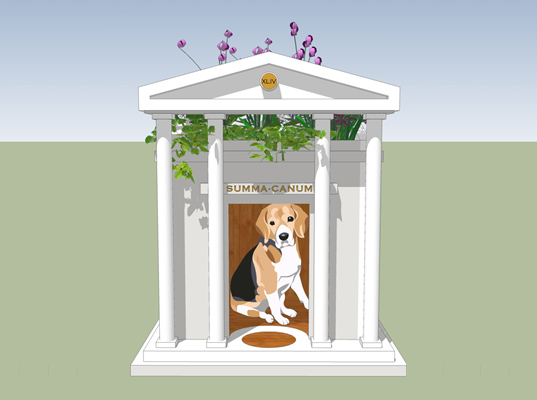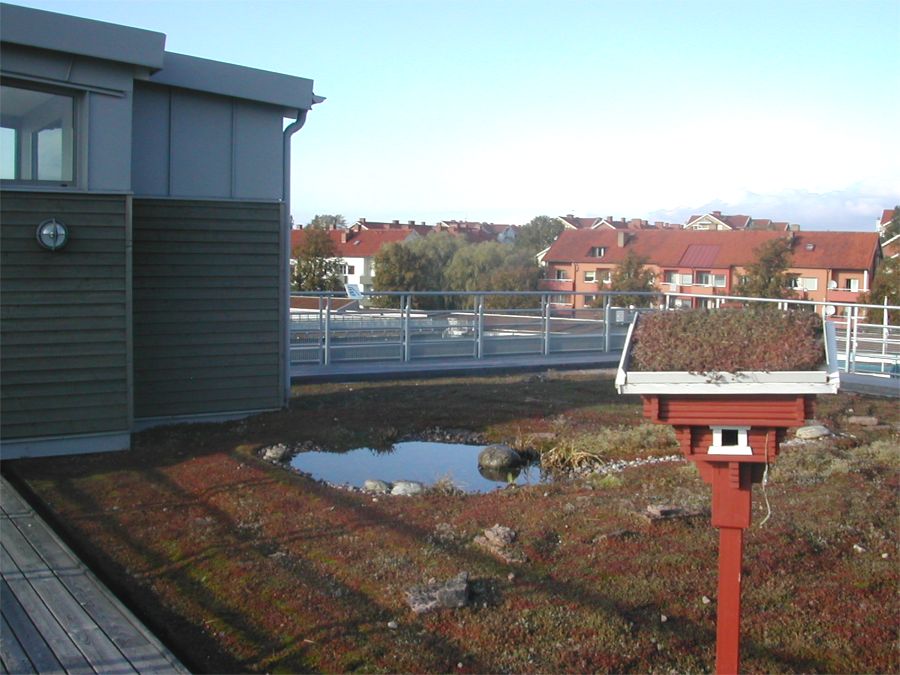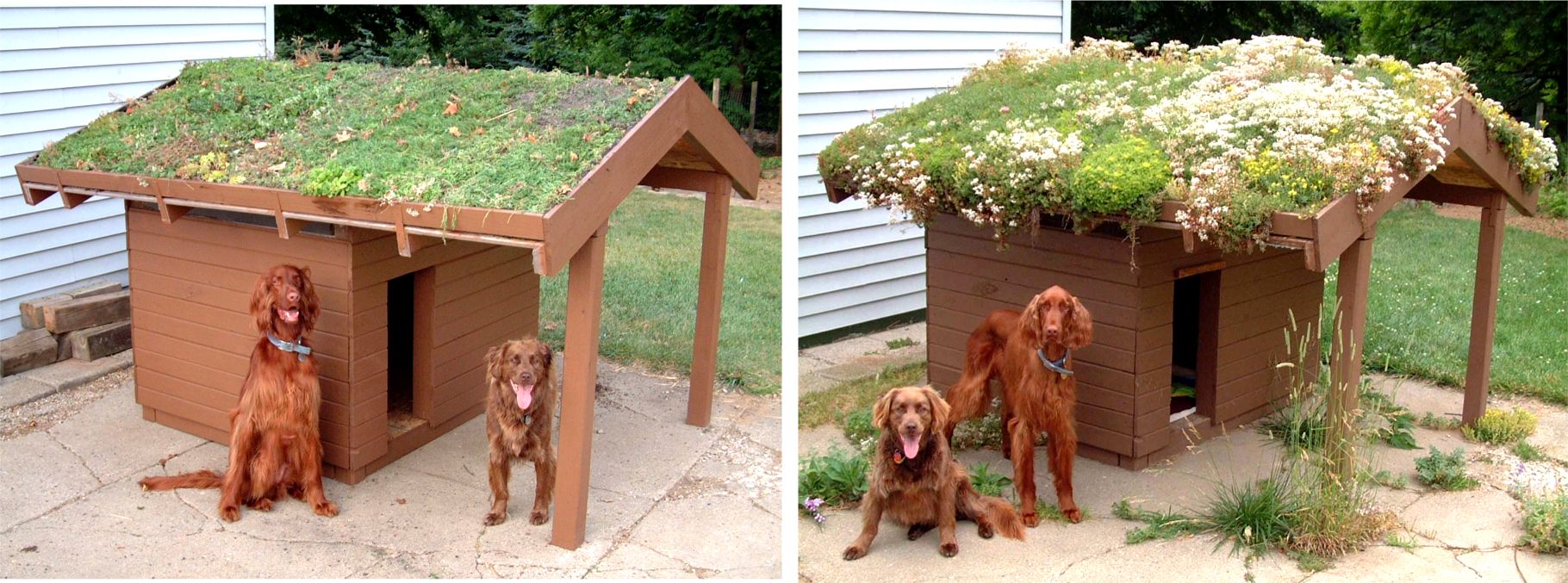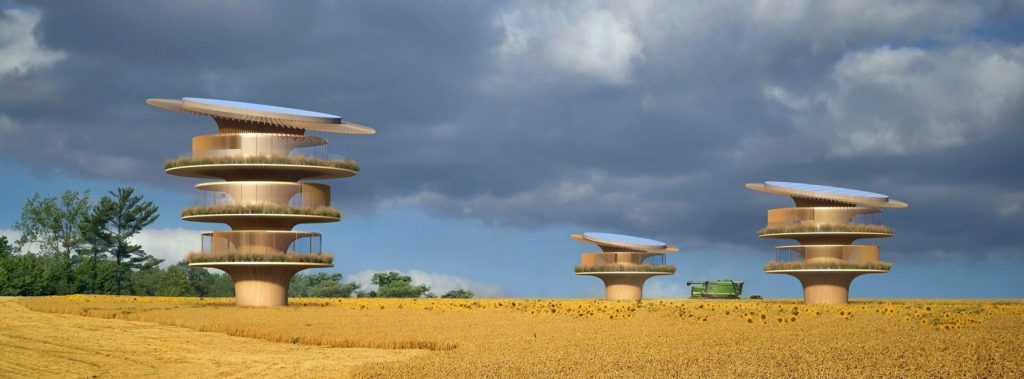I love Inhabitat and think that their postings are always fresh and pertinent, examing what’s new and on the cutting edge of design. But I just have to comment on the post from yesterday, February 19, 2009 –“A Green Roofed Dog House for Obama’s New Puppy!“ A gift for the Obama family from Sustainable Pet Design (makers of Greenrrroof Animal Homes), the Obama Dog Home – Summa Canum (Latin for “Top Dog”) – was “created not only to provide an appropriately sustainable and stylish home for the new leader of the free canine world, but to introduce eco-friendly practices and materials to the American people. ” A fantastic concept, and we’d all like to see the White House itself eventually greenroofed, right? So why not start with a green dog house as a demonstration for all? But as such, shouldn’t it be an example of a feasible option available to the average American, too?
My comments aren’t about Inhabitat, but geared to the company highlighted, the allusion of its name and specifically to their pricing structure. Actually, my commentary is a long time coming, something I have to get off my chest…just give me a minute to rant and then let’s discuss the learning opportunities! I remember first reading about this new landscape designer about a year and a half ago in NovoMetro. We highly regard all things eco-chic and always celebrate ecological design whether boutique or on a grand scale and enjoyed reading about her spunk and youth, and appreciated the modern designs with vegetated roofs for dog and bird houses – see the article in NewsLinks. But the concept of ultra-expensive boutique green architecture being referred to as sustainable irked me then, and even more when I saw so many news sources picking up on this “sustainable” dog house phenomenon…
I’m no one to diss marketing schemes and press coverage – in fact, that’s good old capitalism at its best. And I certainly applaud entrepreneurship, especially when it goes hand-in-hand with ecological design, but doesn’t the term “sustainability” also imply some level of long term economic responsibility? In all consciousness, although the materials may be green, how can these prices be considered sustainable:
Greenrrrooff Animal Homes, Dog Houses:
Extra Small: $1000
Small: $1250
Medium: $1500
Large: $2000
Extra Large: $3000
Couture Homes, Extra Large: $6000
These are obviously specialty items only for the rich – maybe for Paris Hilton, but not for the rest of us. I’m not saying that this company shouldn’t offer these artistic, custom designs to a niche market for the affluent; I am saying we’re not doing ourselves any favors by touting these structures as completely sustainable and the media should be cognizant of this. Regarding the Obama dog house, Sustainable Pet Design says, “Our intent is to create an ongoing testing ground for sustainable practices to which all Americans can contribute. Summa Canum can be retrofitted with solar panels, radiant floor heating, a graywater recycling system…” All awesome and noble ideas for promoting sustainable practices, but at what price?
OK, I can hear it now – Linda, you’ve missed the point: this dog house is made from completely donated environmentally-friendly materials from various companies, including Emory Knoll Farms, and it’s a gift. Yes, but we learn by example and our greatest opportunity for example in the United States lies with our President. The rest of us aren’t going to have vendors and designers donate their materials and expertise to us, and most of us certainly cannot afford even the Extra Small dog house at $1,000!
So what’s my suggestion – not to accept this gift? No, but how about we present affordable options as well? Maybe have a competition for the First Dog’s abode or a fundraiser for animal charities from local Washington, D.C. area school kids to design both dog and bird houses? They could team up with university architecture and/or landscape architecture students or even area design professionals. I’m pretty sure we can get vendors to supply or sponsor materials and would end up with quite a wide variety of conventional built-in-place greenroofs as well as modular ones. This could be in honor of Earth Day, perhaps.
For example, the Augustenborg Botanical Roof Garden in Malmö, Sweden has held very successful greenroofed bird house competitions where school children learn about green design and construction; all the bird houses are put on display for a while for public viewing and the winner gets a place of honor on the roof garden. Our U.S. version could hold the judging and/or auction on the lawn of the White House, and have non-winning entries donated to local animal shelters, schools, etc., with some of the greenroofed bird houses set within the gardens. What a great way to introduce the greenroof concept to many and encourage future generations to embrace ecological design!
Here are a couple of more affordable, and just as fashion-conscious dog house favorites of mine – first is Finn and Cooper’s Dog House from Dr. Bradley Rowe, Associate Professor, Michigan State University, Department of Horticulture (see Michigan State Green Roof Research). Brad estimates the cost at “probably a couple hundred dollars. Most of the cost was in the wood to build the doghouse, not the green roof part. I harvested sedum cuttings off of some of our research plots, bought a few plants, and some were donated by Ed Snodgrass.” The photo at left shows it newly constructed in 2003, and more fully grown in and still being enjoyed at right in July, 2006.
Austin-based Chelsea Bandy of Chelsea+Remy Design and her boyfriend created the following design for the Fall 2007 Barkitecture competition, where local designers, builders and architects were asked to build dog houses with all of the proceeds going to support various local animal rescue groups. Chelsea estimates that the total cost (if nothing were donated and everything was purchased outright) would have been about $500. By the way, that’s Remy on the right!
Aside from the plants, other green materials used included:
-Crushed recycled glass (from local nursery Gardenville) bottles which add some fun sparkle and color to the roof while taking advantage of the “green” factor
-EcoResin 3Form Panels with Capiz shells, donated by 3 Form. (www.3-Form.com) We used these as windows.
-Concrete floor tiles.
-Reclaimed Low VOC faux paint.
-All scrap materials were donated to another building project so that waste was minimal.
Neither of these dog house costs include designer or transportation fees, something to keep in mind (act locally, remember?). The biggest drawback we have right now within the green building industry at large is higher up front costs to implement these new, albeit innovative green materials and services, but we know these will continue to come down as both supply and demand increase. Designing sustainably shouldn’t be an exclusive option only for a few, but inclusive of many. There will always be a market for one-of-a-kind art pieces, but sustainable design as a global concept is important, and completely possible with continued ingenuity. How about some eco-friendly design options for our wallets, too?
 Happy Greening ~ Linda V. next to my own neo-classical style greenroof bird feeder, a gift designed by fellow University of Georgia School of Environmental Design (now College of Environment and Design) graduate (now assistant professor) Shelley Cannady, in 2002 for about $50 using recycled materials and yes, donated succulents from Saul Nurseries (it’s good to have some connections!).
Happy Greening ~ Linda V. next to my own neo-classical style greenroof bird feeder, a gift designed by fellow University of Georgia School of Environmental Design (now College of Environment and Design) graduate (now assistant professor) Shelley Cannady, in 2002 for about $50 using recycled materials and yes, donated succulents from Saul Nurseries (it’s good to have some connections!).
 March 13, 2009 Summa Canum Update: As of March 12, the eco-friendly doghouse is en route to the White House. The Sustainable Pet Design press release says, “Green companies across the country have donated materials and services, including rock legend Neil Young, who is driving it to the White House this month, in his super-efficient hybrid 1959 Lincoln Continental to promote environmentally responsible vehicles; Summa Canum will be riding along in the convoy and delivered to the White House. The dog home generated enough enthusiasm among members of the green community that almost all of the materials were donated.
March 13, 2009 Summa Canum Update: As of March 12, the eco-friendly doghouse is en route to the White House. The Sustainable Pet Design press release says, “Green companies across the country have donated materials and services, including rock legend Neil Young, who is driving it to the White House this month, in his super-efficient hybrid 1959 Lincoln Continental to promote environmentally responsible vehicles; Summa Canum will be riding along in the convoy and delivered to the White House. The dog home generated enough enthusiasm among members of the green community that almost all of the materials were donated.
“Summa Canum is more than a doghouse””it is an effort to promote and introduce sustainable materials to the American public through an accessible object. Sustainable Pet Design and the sponsors of Summa Canum hope to create excitement through the idea that green is cool and patriotic. The interest this generates will provide an opportunity to present greenroofs and eco-friendly materials as concrete ways to decrease climate change and waste, lower health concerns, and provide green jobs.”
Although I have reservations about the pricing of the doghouses for sale on SPD, I do wish you continued success, and offer you kudos for all of your hard work
~ Linda V.
 Greenroofs.comConnecting the Planet + Living Architecture
Greenroofs.comConnecting the Planet + Living Architecture














John Shepley
Hi Linda,
On the topic of sustainable products for the masses, I thought I’d chime in. Baltimore’s ‘green living’ store, named Bluehouse closed it’s doors last week. It was no surprise. Sadly, they seemed to only stock items at the extreme high end of design, uniqueness, and cost. I recall seeing a bedroom set made of reclaimed wood from a barn. But the wood was teak, and the barn was from India!!! For all the old growth heart-pine to be found in the old building of Baltimore, not a splinter to be found in anything there.
At Christmastime, they sold energy efficient LED lights. The exact same same lights that sold at Lowes for $16 and could be bought wholesale for $11; were featured at Bluehouse for $42 / string.
This kind of elite eco-marketing makes no sense to me. No one can afford to turn their back on the big box stores or afford eco-friendly products if the choices are limited to either the rare and exotic or unreasonably expensive.
Ikea gets it, marketing high-quality everyday products at good prices, which were manufactured making very efficient use of resources. Not until american eco-marketing firms ‘get it’ that the marketplace will support new, eco-friendly durable goods that are also a value!
Shep
waterdog
Your criticisms are disingenuous. The doghouse models you displayed would definitely NOT cost only hundreds of dollars retail but thousands. You conveniently left out inconvenient costs such as labor, overhead, etc. Perhaps you don’t understand business? How much can something be sold for when the wood alone costs $500??? Come on! Also, do you have any idea of cost of FEC certified red cedar or any of these other sustainable materials? I looked up this company and saw an LA Times article where they INVITED people to poach their designs and DIY, even offering advice.
I hate it when good people go through the time and effort to do something wonderful only to be ankle-bitten by those who merely snark and snipe. Usually, when an argument makes no sense there is an underlying reason. My guess here would be that green monster, ENVY.
Linda Velazquez
Waterdog,
As always, I appreciate feedback. My post pertained to affordability, sustainability, and responsible promotion by example:
1) There’s DIY and there’s retail. I’m a staunch believer in the free market, so more power to Sustainable Pet Design if they sell a million doghouses! According to the U.S. Census Bureau, in 2007 the real median household income in the United States was $50,233. If the Obama’s get either a Labradoodle or a Portuguese Water Dog as reported, they’d need at least a medium to large-sized abode, costing between $1,500 – $2,000 (non-couture) if bought outright from SPD, most definitely out of range for most families. My first point was to show alternative examples of lower cost greenroofed dog houses for a family who couldn’t afford one of these models but who could make one themselves. People aren’t going to buy in to ecological design if it’s perceived as a luxury item.
Regarding mark up for retail pricing, “How much can something be sold for when the wood alone costs $500???” Whatever the market can bear, of course. And the $500 included ALL the materials listed above, not just the wood.
2) I’m certainly not questioning SPD’s good intentions. If it’s just about the materials, I suppose you can be as eco-friendly with a regular Prius as with a Special Edition Designer Label Prius, if such existed. But if a product is only affordable to the elite few, how can the design itself be sustainable over time? There are always ways to make a better mouse trap – even an eco-friendly one. Along with sociopolitical, cultural and even spiritual sustainability (other topics altogether) environmental sustainability needs to go hand in hand with economic sustainability!
3) My last point was that I feel the President will, intentionally or not, promote by example, and will need to be aware of the social impact of these choices. And the media should be sensitive to the fact that most Americans couldn’t afford this new doghouse, unless it were DIY or a gift. Reportedly, President Obama wants a “pound puppy” and I’d guess that given this philosophy, he’d also be open to lower cost options, along with his gift.
Regarding your last comment, my husband and I just welcomed our first grandchild, Nicholas Joseph, into this world about three weeks ago from our lovely daughter, Anjuli. We are so happy and feel so blessed – I can’t imagine being envious of anything or certainly not anyone! And I haven’t snarked or sniped anyone in years.
waterdog
Show me a business plan for “affordable” yet sustainable and high design products and I’ll defer. You failed in your examples. Here’s a tip: if you pay $500 in materials, you’re looking at a retail figure of about $5,000. Why? Let’s say the entire cost is 500, all inclusive. I still need to buy materials etc. for the next one and I need to actually make some money; that’s 1500. Same goes for the retailer. Now you’re looking at 3000. That’s assuming the manufacture isn’t too labor intensive which this Summa Canum obviously is, incredibly so, their other designs as well. It’s all hand-crafted. This is just basic business 101.
Nothing sustainable starts out cheap and only with glitz and glamor do the masses take notice enough to demand more which opens up the markets to competition. In this regard, these people are providing a wonderful service. Given that the Summa Canum is in fact a gift, I’m sure they took a hit, so they went far beyond “good intentions”; they actually produced something other than hot air. Actually doing things costs money; running your mouth costs you nothing.
Linda Velazquez
Hi Waterdog,
One last comment: You’re right about “Nothing sustainable starts out cheap and only with glitz and glamor do the masses take notice enough to demand more…” One of the reasons that greenroofs have really taken off in this decade is from high-profile examples from companies or governments – sometimes subsidized completely as a result of legal actions (for example, the 2001 Chicago City Hall: http://www.greenroofs.com/projects/pview.php?id=21) – or simply constructed as corporate leaders in ecological design (the 1997 GAP HQ: http://www.greenroofs.com/projects/pview.php?id=26).
Even the dog house company in point believes their products are for the luxury set (the crux of my post), and are marketing them here this weekend at the 2009 Spring Show of “The Luxury Pet Pavilion, host of the nation’s premiere pet products showcase in a luxury atmosphere.” http://www.luxurypetpavilion.com/
The creation of Stephanie Ellis of Pawniquely Yours, her vision is to “create a traveling forum in which luxury pet manufacturers and purveyors of fine pet goods can conduct business with comfort and ease.” The Luxury Pet Pavilion “introduces the most innovative and cutting-edge pet products and pet product inventors from around the world,” and “Eco-pet enthusiasts will love meeting Stephanie Rubin, owner, Sustainable Pet Design. Help your pampered pooch save the planet as Stephanie unveils her latest invention, the green roof dog house!”
The Luxury Pet Pavilion is not all glitz and glamor, though. It also highlights their charity, “Angel On A Leash,” a therapy dog program created by The Westminster Kennel Club, and donates a portion of all booth costs to the organization. Also, “this opulent setting will also include educational programs and other opportunities that will empower pet professionals, bring awareness to pets in need and benefit the entire pet industry.”
I think this is an awesome combination, and Kudos to all, including SPD, for their innovations and contributions to the less fortunate. Read “Luxury Pet Pavilion Kicks off with “Barking Boutique” Celebrity Fundraiser” of March 3, 2009: http://www.prweb.com/releases/2009/03/prweb2197214.htm
The Luxury Pet Pavilion will be held on Saturday & Sunday, March 7th & 8th, 2009 from 10:00am – 5pm at the Westin Bonaventure Hotel, Pasadena Exhibit Hall, 404 South Figueroa Street; Los Angeles, CA.
waterdog
Friend of mine went to that Luxury Pet Pavilion, billed as a green event. What a sham. The only thing sustainable and eco-friendly was the same Sustainable Pet Design. Everything else was just stupid frivolity – dog strollers, cut crystal dog collars, faux Louis XIV cat divans – and from what I hear, the show was a bust, barely attended and all of the exhibitors will no doubt go out of business in this economy.
I contacted Stephanie Rubin. Turns out she was contacted at the last minute by the Pavilion rep to please, please, please come and fill unsold space as a green exhibitor at no charge for the booth. Seems to me that they were using SPD to try and green-wash the event. How much do you want to bet that this is the last Luxury Pet Pavilion for many years to come? And good riddance.
There’s a big difference between what Rubin is doing and what purveyors of dog sorbet, matching human/dog jumpsuits, dog jewelry, etc. are doing. That stupid shit is a thing of the past.
Chelsea
Just a few comments from someone who has built one of these controversial little houses:) I love that Sustainability and Green Design can evoke such passion from both parties…this means that it has finally hit a soft spot in people’s hearts and is on the rise in main stream America! While I would love to see the President take the route of a more affordable solution to a Sustainable dog house, I appreciate the opportunity at hand to give a Green dog house it’s 15 minutes of fame. As seen in high end fashion, the dress with the expensive label will eventually be “knocked off” and will trickle down into the price range of middle class Americans. In the event that a more pricey version of a green dog house ends up on the lawn at the White House, we can at least hope that the publicity and exposure that it receives will spark a greater interest in green building…that eventually green built dog homes would pop up in yards across America. Who knows…someday we humans may be able to afford to build them for ourselves;) Thank you for your time…Remy and I appreciate the opportunity to be featured for our vision of a Sustainable Dog House. Regards to all!
L. Daniel
Is this all a bit ‘over the top’? Who really cares? Except that they should have got a Labradoodle! A much better choice, for numerous reasons!